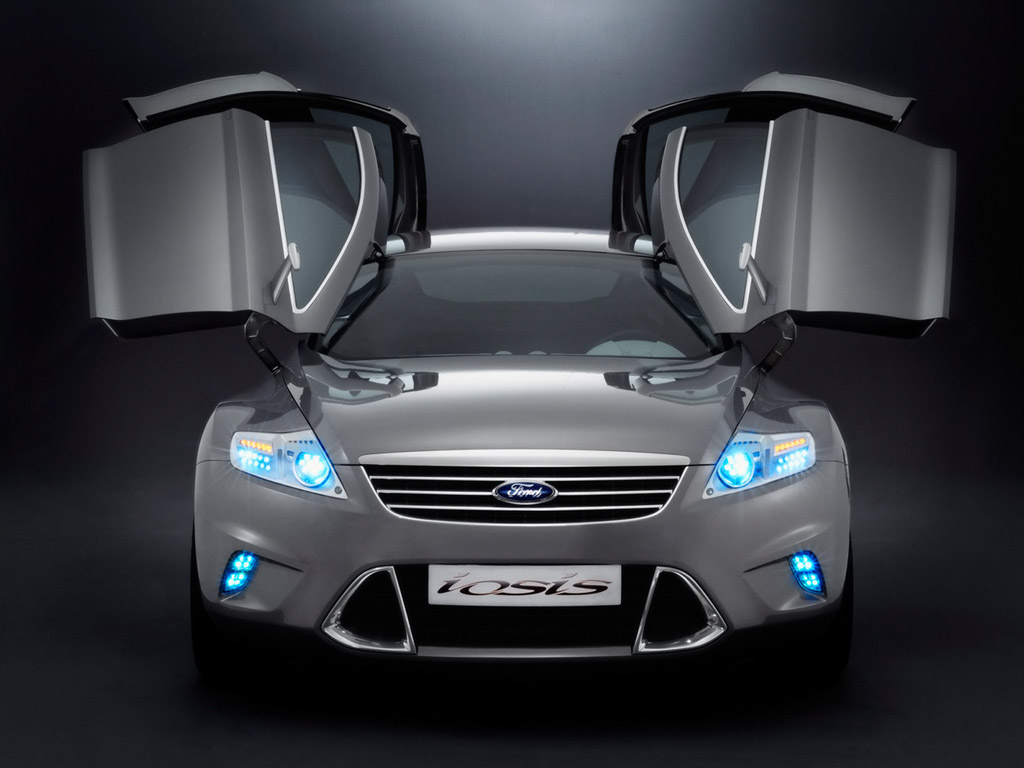2005 Ford Iosis Concept
(from Ford Press
Release) Ford will unveil a head-turning new concept at
the Frankfurt Motor Show to express its design strategy for the next
generation of European road cars.
Styled from a radical new design brief, iosis* is an exciting four-seater
saloon within a muscular coupé profile. iosis follows the recent SAV
concept launched at the 2005 Geneva Motor Show in demonstrating the
company's new "kinetic" design direction; making future Fords look
more sporting, dynamic and exciting.
This startling new design, penned by a team led by Martin Smith,
Ford of Europe's executive design director, showcases visual
elements that will strongly influence a new generation of Ford
products. It is not the precursor to a production model, rather an
indicator of future trends.
"Ford products are acknowledged for their class leading driving
dynamics, our objective, quite simply, is to express this leadership
in our design," said Martin Smith. "We are calling this new language
Ford 'kinetic' design, because we believe it expresses energy in
motion.
"We’re bringing together all of the elements of this exciting design
language into one concept vehicle," he added. "We want this new
expression to make our cars totally irresistible, so they actually
turn heads."
Every car company has
identifiable generations of vehicles and Martin Smith has been
tasked with developing the next generation for Ford. When he arrived
at Ford last year, Smith recognised that Ford's leadership in
driving quality needed to be reflected in the product’s emotional
and visual appeal.
“The forms will be more distinctive and emotional, more athletic and
muscular," explained Smith. "Equally, we have to combine safety and
dynamic performance and still keep the brand identity. The iosis has
great stance, it is powerful, assertive and confident, and it just
cries out to be driven. That’s kinetic design - energy in motion,”
says Smith.
Smith and his team quickly identified the graphic elements that are
the recognised key signatures of Ford design. Amongst the most
important is the ‘inverse trapezoid’ air intake below the grille.
Together, these upper and lower grille graphics represent the new
face of Ford.
A further element considered an imperative by the team, is the
further development of the well defined wheel arch lip originally
pioneered on Focus in 1998.
Rather than static, straight lines, the intention is to make them
more dynamic. The undercut surface supports this aspect and it is
complemented by the kick-up on the rocker panel, which repeats
almost exactly the shape of the "day-light opening" (DLO) graphic.
Another recurring design theme is the kick-up in the DLO at the ‘C’
post, which is echoed in the headlamp design. It is also mirrored in
the design of the hood itself that raises the upper surface to give
a cushioning clearance from engine hard points below. This ridge
then continues along the ‘A’ post and cant rail before terminating
in dramatic cat’s-eye-style rear light clusters.
A particularly dramatic aspect of iosis is its angled pivoting door
arrangement that gives complete, uninterrupted access to the
interior. Constructed from F1-style carbon fibre for lightness, the
doors are powered by ram motors that swing them upwards and outwards
from the ‘A’ and ‘C’ posts via a system of sophisticated hinges that
ensure additional support isn’t required when the doors are open.
Advanced technology where deployed on iosis is practical and
realistic. Mounted in the rear valance is a camera to complement the
two door-mounted units that replace conventional rear-view mirrors.
By using three cameras in addition to the conventional interior
mirror, the driver is assured complete 360-degree vision .
“The interior follows
the same direction as the exterior design,” says Smith.
"We connected futuristic materials with sophisticated materials," he
explained. "There are very technical materials like rubber compounds
combined with leather, and neoprene combined with high quality
aluminium components, for example."
The interior team wanted the driver to be enticed by the interior as
the doors swung open. Immediately apparent is the ultra-modern
steering wheel fashioned from solid aluminium and with contrasting
orange glove-leather grips.
Another example of this approach is in the sequential gear shifter
inspired by the Focus World Rally Car, and located just a hand span
from the steering wheel. Beautifully crafted from solid aluminium
and finished in a unique anodised soft warm brown-grey with orange
leather, it embodies all the themes running through the interior -
contemporary craftsmanship and high quality materials. The starter
button is mounted beneath a flip lid on top of the shifter.
Ahead of the driver is a simple instrument binnacle, featuring the
counterbalanced needles traditionally found on a high quality
chronometer. Between the dials is a high definition LCD screen for
navigation or to display views from the three rearward facing
cameras.
The sweeping centre stack houses docking points for a pair of memory
sticks. It is likely in the future that a conventional key or even
keyless entry will give way to memory stick activation, allowing
full individual driver data to be stored.
The interiors team has developed eye-catching seating for the iosis,
with skeletal frames resembling a ribcage and a vertebrae structure
fashioned from silver carbon fibre and aluminium. Separating the
front seats is a 'flying bridge' centre console housing the
electronic parking brake.
A unique leather finish with a subtle metallic look has been
specially developed for iosis. It retains a natural grain in a deep
charcoal tone, yet the top surface is picked out with a subtle
graphite shade to create the effect.
“The interior architecture is quite simple in itself,” explains
Smith, “but its design shines through in its detailed execution and
the choice of contrasting materials, unusual in automotive
applications.”



